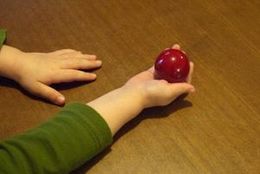I Spy
| We've updated our prices on products from many online Montessori stores! If we've missed your favorite store, please let us know! |
| I Spy | |
|---|---|
| Language - Language Foundation | |
 | |
| Level | Primary |
| Age | 2.5 |
| Prerequisites | none |
| Materials | a collection of objects on a mat or objects around the room |
This is a great supplement to the Sound Blending Game.
The purpose of this activity is to make children aware of the separate sounds (phonemes) that make up words.
Presentations
Note: Do not use the letter names for these games. Use the sounds of the letters.
Beginning Sounds
Introduction
This can be done with one or a few children. It can be a formal lesson that takes place at a table or a mat, or it can be done casually during the course of the daily activities (but of course, do not interrupt a child who is at work with another activity).
- For the child's introduction to the game, make the first clues as obvious as possible: "I spy some thing that starts with 'b' that you are holding in your hand."
- Other ones to begin with are: "I spy something you are sitting on that starts with 'ch'," or "I spy someone who just came in the room whose name starts with 'j'."
With 2 or 3 Objects
- Lay out multiple objects on a mat. Initially, the objects should be very distinctive in their spellings so the clues are obvious.
- Similar to the introduction less, provide clues about the sound of the object.
With Several Objects
- Step one
- Next step
With Objects Around the Room
- The teacher introduces the game. "I'm thinking of something in the room. I will give you clues to help you guess."
- Provide descriptive clues, such as size, shape, color, beginning sounds, or location.
- Pause between clues and encourage several children to guess one at a time.
- The child who correctly guesses can be the next clue giver. The teacher should offer help if the child has difficulty coming up with clues.
Ending Sounds
- Step one
- Next step
Middle Sounds
Points of Interest
- Guessing objects
- Being the clue-giver, although young children may have difficulty giving accurate clues and may change their object mid-way through the game.
- Wondering and finding out the answer
Control of Error
This activity does not have any built-in control of error and must be done with an adult or an older child.
Variations and Extensions
- Once the child can do beginning and ending sounds, you could play the game using just ending sounds. One way to do this would be to use a collection of objects that all have the same beginning sound.
- A version of the game could be played with objects that are not present: "I'm thinking of an animal that starts with 'b'."
Material
The small objects used in this activity are also used in other language activities. It can be nice to have a large collection of these and then swap them out from time to time.
See the page on Miniature Objects for more information on putting together a collection of objects for this activity.
Make Your Own
See the Make Your Own section of the Miniature Objects page for information on how to make these objects.
Where to Buy
See the Where to Buy section of the Miniature Objects page
Further Reading
- A Path for the Exploration of Any Language Leading to Writing and Reading by Muriel I. Dwyer, pages 17-20
- Basic Montessori: Learning Activities for Under-fives by David Gettman, pages 136-137

